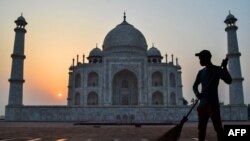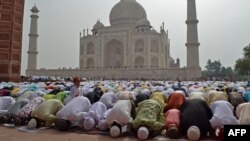A court in India has dismissed a petition by a leader of the Hindu nationalist Bharatiya Janata Party asking that the Archaeological Survey of India be directed to open 22 sealed rooms of the Taj Mahal, to see if there are Hindu idols there.
The Taj Mahal was commissioned by Muslim Mughal Emperor Shah Jahan in the 17th century. Unfounded claims that the Taj Mahal is a Hindu temple have surfaced sporadically over the years mostly from some Hindu right-wing groups.
In his petition to the Lucknow bench of the Allahabad High Court, Rajneesh Singh, head of media relations for the BJP in the temple city of Ayodhya, claimed “some Hindu groups and reputable sants [Hindu ascetics] were claiming” that the Taj Mahal had previously been a Hindu temple dedicated to the Hindu god Shiva.
“Later it was converted into [a] memorial for the wife of Shah Jahan,” the petition said.
In his petition, Singh also said that his main concern was the sealed rooms of the Taj Mahal.
The rooms that the Hindu groups are seeking to be opened were sealed by the archaeological agency for security reasons a few decades ago, several past statements from archaeological authorities said.
“We all should know what's there behind those rooms. Please allow me to go to those rooms and do the research," Singh pleaded in his May 7 petition last week.
On May 12, while dismissing Singh’s petition, the Lucknow bench of the Allahabad High Court said that the question was a “non-justiciable issue.”
“The issues lie outside the court and should be done by various methodology and should be left with the historians. … It is not for the Court to direct what subject needs to be researched or studied. We are not able to entertain such a petition,” the court said.
The claims that the Taj Mahal is a Hindu temple have emerged since Indian writer P.N. Oak published his book, Taj Mahal: The True Story, in 1989. In his book Oak claimed that it was built as a Hindu structure in the 12th century, long before the Mughals invaded India, and used to be known as Tejo Mahalaya or, the Palace of Lord Shiva.
Hindutva – Hindu nationalist – groups claim Shah Jahan converted Tejo Mahalaya to Taj Mahal in the 17th century, the way the Mughal rulers destroyed Hindu temples and converted many of them into mosques.
Hindu groups demand that ownership of the Taj Mahal be transferred to Hindus and say they would use it for their own religious services.
In 2017, in a statement to a court, the archaeological agency said the Taj Mahal was indeed a Muslim mausoleum built by Shah Jahan, to honor his deceased wife, Mumtaz Mahal.
Some leading historians said that the claim that the Taj Mahal was a Hindu temple is ridiculous.
Syed Ali Nadeem Rezavi, who teaches medieval history at India’s Aligarh Muslim University, said that many existing historical documents prove the Taj Mahal was built by Shah Jahan.
“The fact that Shah Jahan built this structure is attested to be not only by the Persian chronicles of the period, but also the travel accounts of several European travelers, and a large number of Rajasthani documents [documents from the northern Indian state of Rajasthan],” he said.
“A number of original Rajasthani documents- known as Arhsatta Imarti [documents related to building construction] and Chitthis [receipts] detailing the Taj Mahal’s building materials, including Makrana marbles from the mines, their cost and the cost of transportation are still there in Bikaner Archives,” Rezavi, known as an expert in medieval archaeology and architecture, told VOA, referring to the Rajasthan state archives.
“None ever mentioned in any historical document that a temple had ever existed at the site of the Taj Mahal or, that it was demolished,” he said.
Made of white marble, the Taj Mahal was built following a typical Persian nine-part plan that had never been found in the past in India, Rezavi said.
“You cannot show any temple, of any period made of white marble, surmounted with a dome, and built following a noni-partite plan. It is ridiculous if some call the Taj Mahal a Hindu structure or claim that it was built at the site of a razed Hindu temple,” he said.
The conspiracy theory that the Taj Mahal used to be a Shiva temple is about as reasonable as the proposals that the earth is flat and the moon made of cheese, said associate professor of South Asian history at Rutgers University, Audrey Truschke.
“The construction and sponsorship of the Taj Mahal, by a Mughal king, are quite well-documented from historical sources in the seventeenth century. It is easily the most magnificent in a series of Mughal mausoleums across northern parts of South Asia,” Truschke told VOA.
“So far as I can discern, there is not a coherent theory about the Taj Mahal at play here so much as a frenzied and fragile nationalist pride that does not allow anything non-Hindu to be Indian and demands to erase Muslim parts of Indian heritage.”
Hindutva iconoclasm should be called out for what it is as these ideologues attempt to falsify and destroy critical parts of Indian heritage, she said.
The national spokesperson of Vishva Hindu Parishad, the largest Hindu organization in the country, Vinod Bansal told VOA Friday that this is not a Hindu-Muslim issue at all.
"Many want to know what exactly is lying inside those rooms which are closed for a long time. The authorities should cooperate, open the doors and help them know the truth behind those sealed doors. The truth should be exposed to the world," Bansal said.
"The Taj Mahal is a World Heritage Site. Nobody will cause any harm to this monument in no situation," he said.

